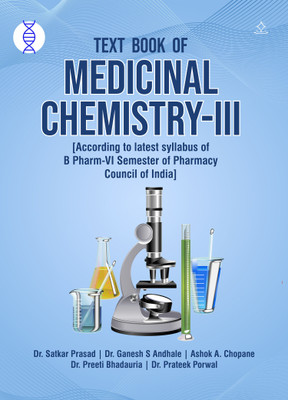TEXT BOOK OF MEDICINAL CHEMISTRY-III - According to latest syllabus of B Pharm-VI Semester of Pharmacy Council of India(Paperback, Dr. Satkar Prasad, Dr. Ganesh S Andhale, Ashok A. Chopane, Dr. Preeti Bhadauria, Dr. Prateek Porwal)
Quick Overview
Product Price Comparison
The Text Book of Medicinal Chemistry ŌĆō III is a comprehensive guide designed to equip students with a deep understanding of modern chemotherapeutic agents, their chemical structures, and their relationships with pharmacological activity. It begins by thoroughly exploring antibiotics, detailing the historical development, nomenclature, stereochemistry, and structure-activity relationships (SAR) of vital classes such as ╬▓-lactams (penicillins, cephalosporins), aminoglycosides, tetracyclines, macrolides, and miscellaneous agents like chloramphenicol and clindamycin. The book provides valuable insights into chemical degradation and classification, enabling students to grasp the rationale behind drug design and modification. It also emphasizes the prodrug concept and its role in enhancing bioavailability and reducing toxicity. The textbook moves on to antimalarial drugs, covering the etiology of malaria and the SAR of quinoline derivatives such as chloroquine, quinine, and primaquine. In-depth discussions on biguanides, dihydrotriazines, and newer antimalarials like artemether and atovaquone are included. The third chapter focuses on anti-tubercular agents, including both synthetic and antibiotic categories, addressing emerging drug resistance issues. It also covers urinary tract anti-infectives, especially fluoroquinolones and their evolution through SAR studies. Antiviral agents form another significant section, with detailed coverage of nucleoside analogs, protease inhibitors, and other antiviral categories that target various stages of viral replication. This is followed by antifungal agents, encompassing both natural antibiotics and synthetic drugs used to treat systemic and topical fungal infections. The section on anti-protozoal agents includes drugs used for amoebiasis, leishmaniasis, and trypanosomiasis, while the anthelmintic chapter addresses helminthic infections using agents like albendazole and ivermectin. The book also dives into sulfonamides and sulfones, exploring their chemistry, historical development, SAR, and therapeutic applications, along with folate reductase inhibitors like trimethoprim. Importantly, the book culminates with chapters on drug design principles, introducing quantitative structure-activity relationships (QSAR), physicochemical parameters, pharmacophore modeling, and molecular docking techniques. Finally, combinatorial chemistry is introduced to highlight high-throughput synthesis methods essential in modern drug discovery. Overall, this book serves as a vital academic and reference resource for pharmacy and medicinal chemistry students, bridging foundational knowledge with contemporary drug development approaches.

